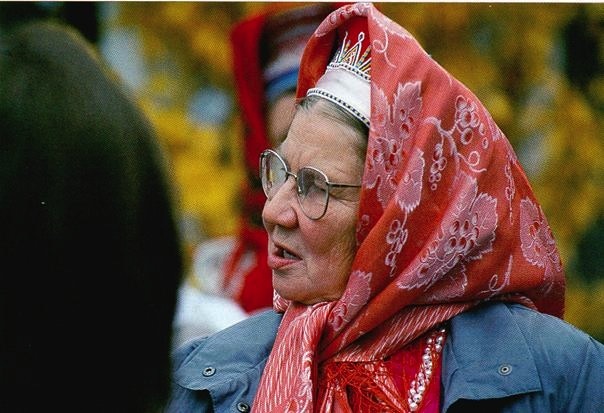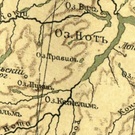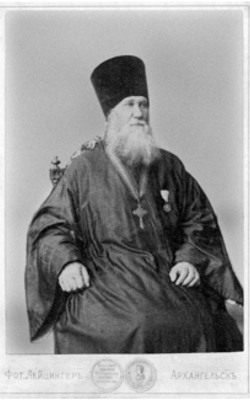Lapps of Nota Lake (Notozero) parish
The Notozero Lake basin, currently the Upper Tuloma reservoir, was the location of the south-western lands of Songelsk and north-western parts of Notozersky settlements (burial grounds). Since their banishment, the Lapps, who spoke the Notozero dialect (abbreviated as “Skolt”), lived in this area. These Skolts can be identified as the forest dwelling Lapps. The territories, which were owned by Songelsk and Notozero Lapps, are marked in Vasily Agalin’s (1547) and Alaya Mikhalkov’s (1608-1611) cadastres.
According to Vasily Agalin: “The Songelsk settlement is situated above the summer lake of Kackimozero, and is inhabited by Lapps pitched in tents, in a total of eight tents there are 21 people and their estate includes sprite rivers and lakes, the Shulo Lake, the Pavia River, the Chervo-Ozero Lake, the Cherya River, Mavno-ozero Lake, Vornakt Lake, Mocahsco Lake, Lovno Lake, the Lovno River, Engost Lake, the Engost River, Kunoy Lake, the Kunya River; and they hunt for beavers in the rivers and in the lakes they fish for white fish and they also own together with the Notozero Lapps the Tuloma River and fish for red salmon in all forms and shapes of upstream Oprich and together with them they control the Notozero Lake and they control the fishing, the estate, rivers and lakes, sprites and the Tuloma River and Notozero Lake, beaver catch and all the lands in-between since ages and with that the monastery estate of Pechensk Monastery to the Bab-ozero Lake, to Kordavarka and to the lands across the Notozera Lapps’ lands and the Notozero Lake to the Gluboky streams.
The residents of the Songelsk settlement were sub-divided into seven branches. Each group had its own chief, who usually was the oldest person in the line. The whole territory was divided among these families into seven family estates. In early spring the family elder with his wife and married sons, loading all the belongings on to the sledges, along with young children and sheep, over the snow crust, would head to the spring grounds, where they had an abode. Here the reindeers would feed on good moss. Awaiting the freshening they fished under the ice and hunted the migratory birds. In May they would head for the fish filled lakes and would fish for cisco; and would be dried. The men would hunt for wild reindeers. In July they would ride their boats to the large lake. During this time the reindeers would be grazing freely. The fishing continued till September. By the end of October or beginning of November, when the lake would freeze and the land would be covered with snow, they loaded their belongings on the Kerezhki (Sami sleigh) and would head to the reindeer moss, where there was a freshening. This was the matting time for the reindeers. They would pass November and December in that place, while hunting, reindeer breeding, repairing winter tackle and only by the end of the year would return to their winter camping grounds. They would carry the stock of fish and meat on their reindeers after the hard ice would set in.
When the Upper Tuloma reservoir was filled I 1965, all the remnants of the Songlesk camping grounds, left after the war, were drowned under the waters from the Kackimozera.
The Notozero settlement is situated above the Kone River (tributary of the River Petcha), it is inhabited by taxed people who live in tents, in a total of 19 tents, housing 28 people and their estate includes the Sovno-ozero Lake, the Kerso-ozero Lake, the Chesmonno-ozero Lake, the Ulits River, the Petch-ozero Lake, the Petch River, the Cosmo-ozero Lake, the Cosmo-stream, the Rudnav River, the Pista River, the Vodonga River, the Mela-ozero Lake, the Para-ozero Lake, the Vuya River and the stream, Suda-ozero Lake, the Girvas-ozero Lake, the Girvas River and streams, the Tovad-ozero Lake, the Tovad River with its streams, the Kochkomo-ozero, the Kochmoga River, the Javr River and all 12 lakes and 10 rivers and 2 streams and in those lakes they fish for white fish, and in the rivers an streams they hunt for the beavers and they fish for the red salmon and the people of the same settlement of the Notozero Lapps, above the Padun line on the Tuloma River fish for salmon with nets from the Kola limits to the Cagli line. The beeches upstream on the Tuloma River to the upper Padun also belongs to them and there they fish for white fish and they own the estate and the rivers and lakes and streams since all times along with their fortresses and in the Tuloma River they fish for Oprich and in the Notozero Lake the residents of Songelsk settlement live since old times in their Lumvom estate” (Yefimenko 1878).
This was one of the largest settlements as per territory and population, situated in favourable climatic conditions of the Kola Peninsula. The whole territory comprised of pine and mixed forests, whereas the Tundra was restricted to the local hilltops. The population of these settlements increased nearly every year (table 1).
Table 1.
Population growth in the end of XVI – the start of XVIII centuries in the territory under consideration.
| Settlement | 1574 г. | 1608 г. | 1716 г. | |||
| Number of tents | Male | Number of tents | Male | Number of tents | Male | |
| Songlesk | 8 | 21 | 6 | 27 | 6 | 48 |
| Notozero | 19 | 28 | 10 | 34 | 6 | 58 |
According to the census of the Russian Empire of 1861 the Songelsk settlement had 137 residents of both genders and in 1886 the number was 165. In Notozero it was 221 and 213 people respectively (N. N. Kharuzin, 1890).
The territory of the settlements was rich in birds, furry animals and the rivers were full of beavers, whereas the clean rivers and streams had pearls in them. The Tuloma River was rich in salmon. Both the settlements had joint ownership of the estate. Near the southern limits the Songelsk settlement owned the Saariselkä hills (in modern Finland) together with the Notozero settlement, which had hunting grounds for wild reindeer. Place names and legends talk of an abundance of reindeer in the given territories (for example the “Tallow tundra”).
After the establishment of the Pechenga Monastery by Reverend Tryphon, the residents of the settlements fell under his economic oppression. In 1556 Tryphon received a ratification and grant from the Moscow Tsar, Ivan the Terrible, which granted the Monastery vast land ownership, including fish rich water bodies. The monks kept this grant as a precious belonging, using it to claim, from the Lapps their ancient estate. The baptized Jew Tryphon (real name Mitrofan) was born, approximately, in 1500 in Torzhok and died on 15.12.1583. In his youth, he led a gang of outlaws, who looted the Russian north. Once he killed his lover in extreme rage, which caused him to leave his illegal life and became a recluse, finding solitude in the outfall of the Petchanga River (currently this place is about 135 km from Murmansk). In 1553, using the money donated by Moscow’s nobles, apparently to enlighten the Lapps, he established the Trinity Pechenga Monastery. The fraternity just baptized the Lapps and of course did not enlighten them. But the monastery rapidly grew, engaging in the trade of fish, walrus fat, furs, pearls and gold, all the way with Netherlands. According to N. N. Kharuzin’s opinion the Pechenga Monastery brought nothing to the Lapps, except for evil.
In 1920 the Russian researcher Andreev proved that the grant by the Tsar was counterfeit. It looks as if Tryphon’s shady past, in which he confessed to sin and looting, never really became a thing of the past.
In 1590 the Pechenga monastery was demolished by the Swedes. The monastery was shifted to Kola and was renamed as the Novo-Pechenga (New-Pechenga) or Kola Monastery and was later liquidated.
It was only in 1764 that Catherine the II terminated all privileges to the monasteries.
The relationship between the monastery and the Lapps of both the settlements have a reflection in the documents, saved by the Songelsk Lapps. The oldest of the documents dates back to 1601 and the newest to 1775.
The Lapps of the Songelsk settlement were baptized in the church of the Baptism of Our Lord in Songelsk, as well as in their own lands, near the lake Alla-Akkajarvi, where they had their winter camping grounds in those days, and later was renamed as Ristomen-Syyet, i.e. Baptized settlement and at the Paz River at the Pazreka camping grounds (currently known as Borisoglebsky settlement). There even was a church school in Songelsk, which was headed by Mikhail Terentiev.
Initially the residents of these settlements were considered as the parishioners of the Kola cathedral, but in 1862 the independent Notozersky parish was established. The church of the Notozersky parish was built under the supervision of the appointed priest Terentiev Georgie Kirillovich, in 1866 for an expense of 1782 roubles and 41 kopecks, released by the St Synod and donations and was dedicated on 17 December 1870 to honour the Baptism of Our Lord. The church’s first priest was the Laplander Anisim Moshnikov. There was also a church in the Notozero settlement, built in the honour of Resurrection of Christ.
Both the churches in Songelsk and Notozero were built by the Lapps and were shifted from place to place many times. These churches held two services a year: on Easter and on 6 January in Notozersky – in January and one of the weeks of the Great fast, when the local Lapps went for confession and communicate.
The unique Kola archive, stored in a pine chest, was handed over by them in 1031 to the Minister Interior of Finland, Niilo Solja (Solya). The documents from this archive were translated into Finnish and sent to Helsinki in 1941.
A part of the same documents was published by N. N. Kharuzin in 1890 in his book “The Russian Lapps”. He was assisted in using these documents by the local Russian officer, who was trusted by the Lapps.
The historical significance of these documents is very great. They depict the every day life of Sami Skolts (Lapps of Notozersky parish) encompassing a period of two centuries. These documents show that the monks tried all means to take-over the Lapps’ territory and the Lapps fought for their rights.
In many of the imperial decrees sent by the Moscow based Tsar, the monks were forbidden from oppressing the Lapps and taking over their lands. Peter the Great, in the very beginning of his rule, studied all the previous documents regarding the conflicts between the monks and the Lapps. All the fake claims by the monks were discarded and the Lapps regained their rights.
The boundary of the Lapps’ estate by the Tuloma ran through the middle of the river bed, along the Kalipukh threshold. Above that were the old fishing areas of Notozersk and Songelsk residents registered to them in cadastres. The residents of both settlements rightfully complained about the infringement of this ancient boundary by the Pechega monks, the Kola Tselovalniks and peasants, who fished in Tuloma rapids above the Kalipukha, which greatly affected the residents of both the settlements.
The decree by Peter the Great invoked the most ancient legal basis for the ownership of fisheries on Tuloma River by the Skolts. In Vasily Agalin and clerk Stepan Fedorov’s cadastre, written in 1592 you can see: “The Notozersk and Songelsk Lapps own the Tuloma River above the Padun and the threshold and they fish for white fish; the boundary runs along the Tuloma River up to upper Padun; according to the imperial grant in the Notozersk estate the Kola monks and tselovalniks and peasants have no right to fish in the Tuloma River and in all the lands and are not allowed to own anything in those lands and rivers and the Notozersk and Songelsk Lapps remain legal owners as before”.
The document also points to the dishonesty, which was involved in the way the Allay Mikhailov cadastre showed the property of the Pechenga Monastery. The decree incriminated that “the way the Swedes fought near the Kola stockade and better than many the locals took over Polonius and took the estates and fourth of the Tuloma River and how the wonderers took over the Pechenga monastery and how Allay Mikhailov the scribe registered the fisheries to the monastery during the war time not disclosing it to the Lapps and therefore all the cadastres of Allay Mikhailov should be ordered defunct”.
The royal decree cancelled all sale-purchase, pledge and grant documents, signed by the residents of Notozersky and Songlesk settlements in favour of the Pechenga Monastery or the representatives of the Kola administration and ordered trials for all who were involved in embezzling the ancient ownership rights, which belonged to the Sami communities. The decree concluded: “…the Lappish estates cannot be sold or pledged and upon the request of the Lapps, file cases against the heads of the Pechenga Monastery and establish the truth in the court”. “…and those estates (lands) to be owned by the Lapps as before, because our royal decree establishes this, as before the petition of the Pechenga elders and annul as before their petitions… and pass this Royal decree by the Great Sovereign to the Notozersk and Songelsk Lappa so that they would from now on own the abovementioned fisheries and the catch therein. Written in Moscow in the summer of 7205, March 30th. Peter.
This same time is also indicated in the oral legends of the Lapps of the Nota Lake area (Notazersky Lapps).
In fact the legal enforcement was effective only for 70 years. The following lawlessness continued till the reign of Nicholai the First.
It is worth noting that unlike the rest of Lapland, this area deep inside the continent stayed free of European colonial aggressions for a long time. This was due to the fact that the Russian economic interests extended to the shores of the Barents Sea, where there was ample marine riches and hunting opportunities, whereas the Finnish and Scandinavian influence was kept out by the Empire’s boundaries. The history of demarcation of boundaries among Russia, Norway, Sweden and Finland is very long. In fact there was natural boundary, which was effective for centuries and divided the Sami (Lapps) into various cultures – Scandinavian and Russian, who differed from each other not only by their language, but as per lifestyle also (Kharuzin, 1890). Catherine II made the first attempt at drawing the line in 1784. But it was only after Finland became part of Russia in 1809 that the problem was partially resolved. Till this time the Russian Lapps paid taxes to two sovereigns and those living in the border areas paid to three. Allay Mikhailov’s cadstres show that apart from paying the onion tax to the Russian emperor, the Lapps also paid 10 Altyns (three kopeck coin) to the Danish king.
In 1921 Russia and Finland signed the Tartu Treaty, establishing the new state boundaries, according to which a large part of Songelsk settlement and the western part of Nota Lake (Notozersk) area ended up in Finland. Therefore for many years the western part of the said area was closed to Soviet economic interests. On the other hand the Finnish law of 1925 about the population of Petsamo did not cover the formerly Russian parts. The border was finally demarcated in 1826. All of this helped the Lapps maintan their way of life until 1939, when the given territory became a battle ground.
By the end of the Second World War the boundaries were redrawn and parts of Songlesk and Nota Lake (Notozero) settlements again became parts of Russia. However, part of Lapps, who knew about the repression of native people in the USSR during 1937-1939, accepted the Finnish government’s offer and voluntarily settled in the Finnish province of Inari.

The older generations of Sami-Skolts, who live in Northern Lapland, still follow their traditional lifestyles (Luhta, 1998).
Saam Scolt 2
The older generations of Sami-Skolts, who live in Northern Lapland, still follow their traditional lifestyles (Luhta, 1998).The people of the Notozersk (Nota Lake) settlement have not changed their traditional dislocation. Naturally all the dislocations took place within the territory of the settlement. First of all the dislocation was caused by the demarcation of Russian-Finnish border, then because of the creation of collective farms and by the beginning of the WWII the people were deported from the military controlled territories and areas prone to air strikes (Ristikent).
After that the dislocation was caused by the construction of the cascade of HEP on Tuloma River and because of the flooding of the upper and lower reservoirs. There was a geographical change in their winter camping areas. But the Lapps remained at reasonably close distances from their harvesting areas. The combined study by Norwegian and Russian scientists to identify the memorials of Sami culture of the Nota Lake and Songelsk settlements, showed that Lapps from the Notozero and Songelsk areas continued enjoying their tradition crafts in their ancient lands before the massive deforestation during 1957-1970. In the 1970s the area lost all resources for reindeer breeding. The Lapps mainly worked as timber cleaners and in agricultural sector, which was totally untraditional for them.

